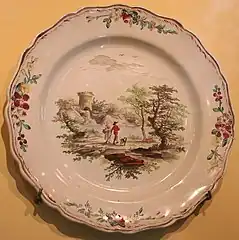 Porte montre | |
| Founded | 1749 |
|---|---|
| Founder | Honoré Savy |
| Defunct | 1790 |
| Headquarters | , France |
| Products | Faïence |
Honoré Savy (1725–1790) was the founder of a factory that manufactured faience wares in Marseille, France, between 1749 and 1790. He is associated with the Veuve Perrin and Leroy factories.[1]
History
Around 1749 a new period of faience manufacture began in which the first factory was established by Honore Savy in which polychrome decoration succeeded the earlier style using blue with some violet. A letter of 27 September 1765 to M. Bertin described Savy as a master of fayance fabrication for fifteen years.[2] In 1765 Honoré Savy applied for permission to start making porcelain. The minister, Bertin, was discouraging.[3] That year he became a member of the Royal Academy of Painting and Sculpture of Marseilles.[1]
In July 1777 Savy was visited by Monsieur, the king's brother, later Louis XVIII of France. Monsieur inspected a large display of all types of faience in the workshop's gallery, but there is no mention of porcelain. Monsieur placed the factory under his protection, and gave permission for it to use his arms, and to display a statue of the prince in the gallery. A Marseille business directory for 1779–80 listed Savy as making both enamelled faience and porcelain.[4] Childless, Savy continued his work until his death on 24 September 1790.
Products
Honoré Savy used classic themes of decoration: flowers, landscapes, seascapes and fish. He was the inventor of a green color, drawn from copper, used on pieces of monochrome green.
Gallery
The Musée de la Faïence de Marseille has an important collection of work by Honoré Savy
 Tureen decorated with fish and other seafood
Tureen decorated with fish and other seafood Circular plate
Circular plate Oblong bowl
Oblong bowl Oblong dish in the shape of a shell with a scalloped edge
Oblong dish in the shape of a shell with a scalloped edge Plate with rural scene either by Honoré Savy or by Veuve Perrin
Plate with rural scene either by Honoré Savy or by Veuve Perrin
References
Citations
- 1 2 Campbell 2006, p. 87.
- ↑ Davillier 1863, p. 97-98.
- ↑ Jacquemart 1877, p. 577.
- ↑ Davillier 1863, p. 109-110.
Sources
- Campbell, Gordon (2006-11-09). The Grove Encyclopedia of Decorative Arts: Two-volume Set: Two-volume Set. Oxford University Press. ISBN 978-0-19-518948-3. Retrieved 2012-11-29.
- Davillier, Charles (1863). Histoire des faïences et porcelaines de Moustiers, Marseille et autres fabriques méridionales. S. Castel. Retrieved 29 November 2012.
- Jacquemart, Albert (1877). History of the ceramic art: A descriptive and philosophical study of the pottery of all ages and all nations. Scribner. Retrieved 2012-11-29.